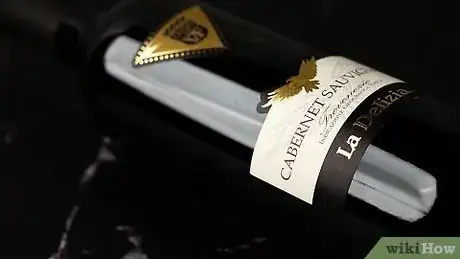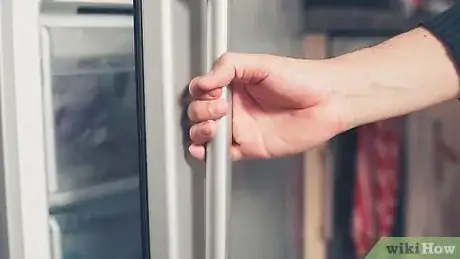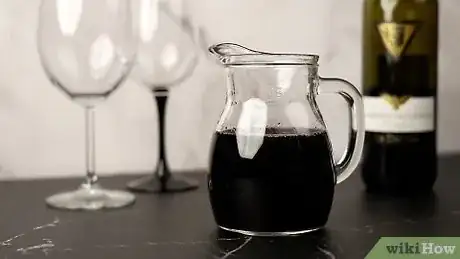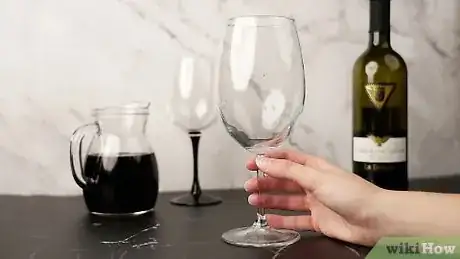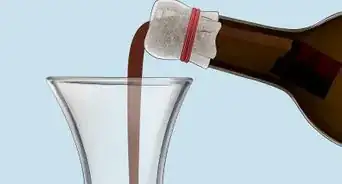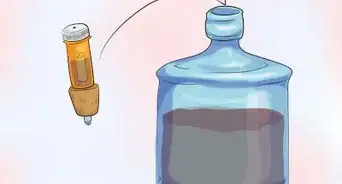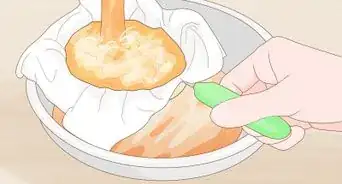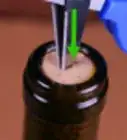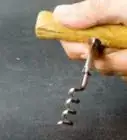wikiHow is a “wiki,” similar to Wikipedia, which means that many of our articles are co-written by multiple authors. To create this article, volunteer authors worked to edit and improve it over time.
There are 7 references cited in this article, which can be found at the bottom of the page.
The wikiHow Culinary Team also followed the article's instructions and verified that they work.
This article has been viewed 171,631 times.
Learn more...
Cabernet Sauvignon is one of the better known full-bodied red wines. It was originally produced in the Bordeaux region of France and has been popular for centuries. California has become a popular producing region for domestic Cabernet. The bold and hearty flavor of the Cabernet Sauvignon is highlighted when it is properly served. Follow the steps below to learn how to serve Cabernet Sauvignon.
Steps
-
1Choose your desired wine.[1]
- When choosing a Cabernet Sauvignon, remember the phrase "old before young." You will find with age, the characteristics of the wine have mellowed and smoothed. Younger wines are generally sharper and may overpower foods they are meant to compliment.
-
2Cool the bottle at a temperature range of 63 degrees Fahrenheit (17.2 degrees Celsius) to 65 degrees Fahrenheit (18.3 degrees Celsius).[2]
- Many people make the mistake of either over chilling a Cabernet Sauvignon or letting it stand at room temperature. Room temperature is a proper term to use when referring to the serving temperature of a Cabernet Sauvignon, however there is a stark difference between room temperature in Florida and room temperature in Iceland.
- A good guide to reaching the proper serving temperature for a Cabernet Sauvignon is to place the bottle in the refrigerator for 20 minutes or in an ice bucket for 5 minutes.
Advertisement -
3Properly aerate the wine.[3]
- Aerating, or airing, the wine is the best way to open it up to its full flavor. This is the process of letting the air blend with the wine, which reduces the high carbon dioxide levels that may be present. It also removes the accompanying odor that can mask the true aroma.
- Uncork the bottle and let it sit open for an hour.
- Pour the wine into a wine decanter. The wider opening of a decanter allows aerating to occur faster.
- A decanter is a container that is used to hold the wine after it has been decanted. Decanters are normally used as serving vessels for wine.
-
4Decant the wine.[4]
- Decanting is the process of separating sediment from the wine. Contrary to popular belief, sediment does not always indicate a wine has gone bad.
- Sediment in red wine is created over time by the breakdown of pigments and tannin within the wine. As time matures the wine, small amounts of these 2 compounds gradually settle at the bottom of the bottle.
- Leave the wine bottle in an upright position for 24 to 36 hours prior to decanting.
- As much as 1 inch (2.5 cm) to 1.5 inches (3.8 cm) of the bottle of wine may not be consumed due to sediment, depending on the age of the wine and the grapes used.
-
5Choose the proper glass.[5]
- Bolder, more full-bodied and complex wines like the Cabernet Sauvignon benefit from a wine glass that is large, round and has a wide rim.
- Hold the wine glass by its stem. This prevents the wine from warming due to the temperature of your hands.
- Warming a wine above its desired serving temperature will yield unwanted and unpleasant characteristics within the wine. The alcohol in wine will give a sharpness to the taste if the wine is served above its optimal temperature.
-
6
Community Q&A
-
QuestionCan I keep an open bottle of wine in the refrigerator?
 Community AnswerYes. The cold will slow the decay of the wine into vinegar. An open bottle stored in the refrigerator will stay good for about a week. An unrefrigerated open bottle may go bad within a few days.
Community AnswerYes. The cold will slow the decay of the wine into vinegar. An open bottle stored in the refrigerator will stay good for about a week. An unrefrigerated open bottle may go bad within a few days. -
QuestionWhat meats go well with red wine?
 Community AnswerLamb and beef go best with red wines, but you can use most other types of meat as well.
Community AnswerLamb and beef go best with red wines, but you can use most other types of meat as well. -
QuestionI'm serving pasta with a red sauce, will my Italian Cabernet compliment my meal?
 Community AnswerAbsolutely. It will go especially well if your pasta contains a red meat, like ground beef or sausage.
Community AnswerAbsolutely. It will go especially well if your pasta contains a red meat, like ground beef or sausage.
Warnings
- Wines should be clear. There could be sediment, but the overall look of the wine should not be cloudy. A cloudy wine can indicate bacterial spoilage and should not be consumed.⧼thumbs_response⧽
- The wine is most likely damaged if the cork is not intact, it is cracked or it looks as though the wine has penetrated it.⧼thumbs_response⧽
Things You'll Need
- Wine decanter
- Wine funnel
- Wine filter
- Large wine glass
References
- ↑ https://www.thekitchn.com/how-to-choose-good-cheap-wine-53966
- ↑ https://www.wineturtle.com/should-red-wine-be-chilled/
- ↑ https://www.youtube.com/watch?v=uzqtnEGdE5c
- ↑ https://www.thekitchn.com/do-you-have-a-wine-145131
- ↑ https://www.winemag.com/2018/10/30/how-to-select-the-right-wine-glass/
- ↑ https://www.thekitchn.com/the-little-secret-to-pouring-the-right-amount-of-wine-238180
- ↑ https://www.youtube.com/watch?v=ZkqfzRfR_YQ
About This Article
To serve cabernet sauvignon, start by chilling the bottle in the fridge for 20 minutes or in an ice bucket for 5 minutes so it's between 63 and 65 degrees Fahrenheit, which is the perfect temperature for cabernet sauvignon. Then, uncork the bottle and let it sit for 1 hour to aerate it, or pour it into a wine decanter so it aerates faster. Next, when you're ready to serve the wine, pour it into a wine glass with a large, round bowl and a wide rim. As you're drinking the wine, hold the glass by the stem so you don't warm the wine with your hands. To learn how to decant wine before serving it, scroll down!
